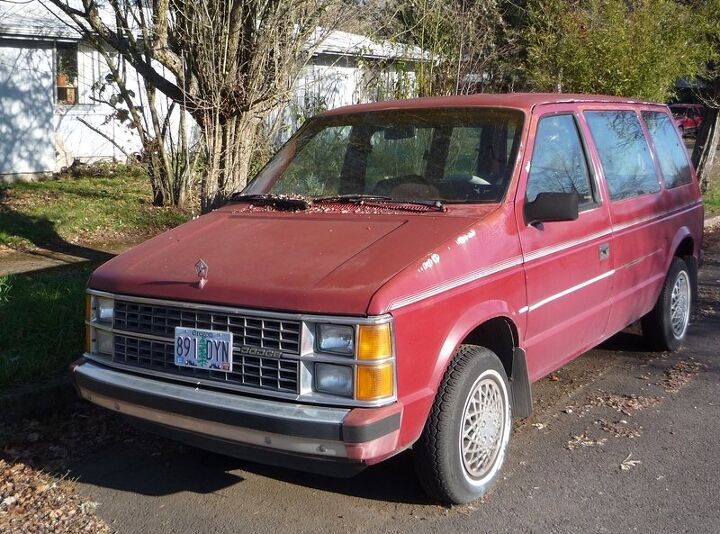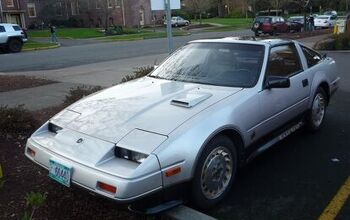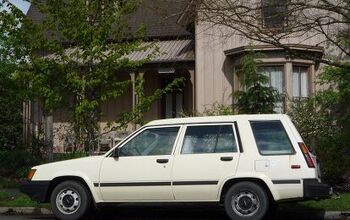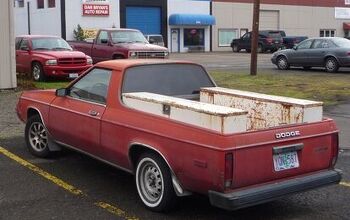Curbside Classic: 1984 Dodge Caravan

There’s nothing truly original in the car business. Everyone begs, steals and borrows from everyone else. Or sometimes, the same (and usually obvious) idea ferments for years in various heads or companies, and then suddenly appears in the same format at the same time in totally different places. How about the modern FWD mini-van? It first bubbled up in two totally different branches of Chrysler, sat for years,and then suddenly sprang forth, one in the US, the other in France, both at the same time. Coincidence, or is it just that every idea has its day in the sun? For the minivan, that would be 1983. In France, it was the Espace; in the US it was the Dodge Caravan/Plymouth Voyager.
We’ll touch on the Renault Espace again later, whose history is convoluted but less contested historically than the Chrysler minivans. Lee Iaccoca and Hal Sperlich, who left Ford in for Chrysler in 1978, will tell you that they conceived of a “Minimax” project at Ford in the seventies and pitched it to Hank II, who turned them down. Chrysler historians have plenty of evidence that they were at work on a similar project during the early seventies, a “garageable van”. Both concepts initially were based on RWD chassis, there being no suitable FWD platforms in those days of yore. Realistically, they were more like a cross between traditional wagons and the large vans of the time. Probably both were true, and very likely someone at GM had the thought too.
Hal Sperlich was particularly enthusiastic of the concept; whether it was from his ideas at Ford or what he saw at Chrysler is unknown. But in 1978, development began in earnest, and customer input dictated the program: room enough between the rear wheels for a 4×8 sheet of plywood, removable and flexible seating for up to seven, a sliding door, bucket front seats to allow Mommy to attend to the bawling kids in the back. Now the idea needed a donor platform.
By this time, FWD was deemed essential, as early prototypes with slant sixes and RWD intruded too heavily in the passenger compartment. Chrysler’s Simca-based Horizon/Omni offered the first opportunity, but Sperlich wisely decided to hold off until the larger K-car platform came along a couple of years later. Additional delays because of competing demands and Sperlich’s desire to get it right the first time delayed the final product until the fall of 1983, when it was introduced to a highly receptive market.
The timing was excellent: the second energy crisis was still just winding down, so efficiency was still big on everyone’s mind. With only four cylinder engines, and a body shorter than the K-car sedans, the Chrysler T-115 vans had that covered pretty well. And the baby boomers were hitting the reproductive phase of life, and were more than willing to try something different than ye olde Country Squire that they had thrown up in. The minivans were born under an auspicious sign.
Before we get into the guts of the so-called Magic Vans, lets quickly pick up the story of that other 1984 mini-van pioneer, the Espace, because it also got its start under Chrysler’s roof, but in England. Europe UK (formerly Rootes) designer Fergus Pollock, who later was senior design manager at Jaguar, developed a van project in the seventies, about the same time as Giorgetto Giugiario’s highly influential 1978 Megagamma concept for Lancia.
Pollock’s design focused on the one-box approach, whereas the Megagamma retained the vestigial hood that the Caravan also appeared with. Of course one can likely find numerous earlier designs, even production ones, that will be thrown at this argument, but the Megagamma’s FWD layout, package and lines are unmistakably apparent in the Voyager/Caravan, and to some extent in the Espace. Lets not forget the line at the top of this article. And let’s also not forget that the Megagamma’s first offshoot saw the light of day in the 1981, as the Nissan’s Prairie/Stanza Wagon, one of our first Curbside Classics. That predates both of the “pioneering” minivans by at least three years.
To wrap up the Espace story, Chrysler sold its European ops to Peugeot in 1978, and the Espace was going to be a Talbot, which is what Simcas were rebadged as under their new owner. Matra was doing the lead work on its development, and when Peugeot chickened out, Matra took the project to Renault, who bit. But the first gen Espace still was full of Chrysler/Talbot parts. You will be tested on this tomorrow.
Enough of the fuzzy early history of the Chrysler bobsy-twins. What actually and finally appeared in the dealers on January 1984 was a remarkably innovative car, for conservative America. The first few years of production were strictly the short-wheelbase versions, whose seven passenger seating was a bit iffy all the way around. And lest I forget, there was an eight passenger version, with a bench seat(!) in the front. Try finding one of those now; it’s getting iffier just to find the early versions at all.
The one I found here is a five passenger version, which was not just a seven-passenger without one row of seats. The back seat was full-width, and was further back than the middle seat of the Mormon-family version. I seem to remember that the front bench also came with this setup, creating a rather traditional six-passenger arrangement straight out of the old days. In any case, the five seater had a very decent rear cargo area; the seven had next to nothing. It was a painful compromise, along with painfully short legroom that led to the much happier long-wheelbase Grand versions in 1987.
Power? What power? These early vans were rather pathetically lacking in that respect, with the standard 2.2 Chrysler four belching out all of 84 hp, while the optional “Silent Shaft” 2.6 liter Mitsubishi four had some 104 hp, more or less, depending on the exact year. A floor-mounted stick was fairly rare, but this one has it, and was preferable for a bit of zest compared to the three-speed Torque-Flite three-speed transaxle. At least it was reliable, unlike it’s self destructing but smother-shifting A-604 Utra-Masochistamatic that darkened our skies beginning in 1989.
The little vans that could were a runaway hit for Chrysler, and not just at the beginning. They were still selling at or close to list price into the early nineties, as I know from personal experience, having written a check for $22k in 1992 for a mid-line Grand Caravan. That’s solidly over $33k in today’s money. Live and learn. And for Chrysler, it was build and earn; by the billions (of dollars). The mini-vans were the cash cows that made Chrysler into the highly profitable company it once was.
It didn’t hurt that both GM and Ford bungled their mini-van competition royally, to the point they finally threw in their towels. That alone is one of the stranger stories in recent automotive history. It took Honda and Toyota to take on the Caravan/Voyager, and finally destroy Chrysler’s hegemony of the market. Who could have seen that in 1984?
The long-wheelbase versions were a big improvement, and eventually the short version went bye-bye, replaced today by vehicles such as the Kia Rondo and Mazda 5. Along with the extra length, Chrysler finally threw in a V6 engine, even if it was Mitsubishi’s. It took several years more before Chrysler’s rugged 3.3 V6 appeared, and in the meantime, it resorted to some creative moves to satisfy the now power-hungry Mommies. Since Mitsubishi could only deliver so many V6s, Chrysler drafted the turbo 2.2 four for mini-van duty, a rather unlikely combination. And contrary to those that claim otherwise, the turbo found its way into the Grand versions too, as some friends unfortunately had one. With its turbo-canyon and no low-end torque, it was an improvised stop gap that desperate buyers were willing to stomach, if only briefly.
A world without Chrysler minivans is hard to imagine now. They just HAD to happen, as did videotape, the internet, and ipods. And in each of those cases, their inventing weren’t exactly as simple as Sony, Al Gore and Apple. But in these times of fuzzy history and denial of evolution, Chrysler duly deserves to join them as the inventor of the mini-van. Amen.
More new Curbside Classics here

More by Paul Niedermeyer
Latest Car Reviews
Read moreLatest Product Reviews
Read moreRecent Comments
- ToolGuy TG likes price reductions.
- ToolGuy I could go for a Mustang with a Subaru powertrain. (Maybe some additional ground clearance.)
- ToolGuy Does Tim Healey care about TTAC? 😉
- ToolGuy I am slashing my food budget by 1%.
- ToolGuy TG grows skeptical about his government protecting him from bad decisions.











































Comments
Join the conversation
My 1995 Voyager SWB 3 Litre V6 without Over Drive must have been built on a Wedenesday. Been pretty good besides the typical AC, Tranny, and radio issues. My parents wanted a stick shift, but by August 1995 the only new ones were slush boxes. Kind of funny you paid $22K for one since my folks only paid $18K, but that was probably due to the fact the 1996s were coming in and the 1995s were not cool. Almost 16.5 years old and almost 160K miles.
Just wanted to mention that I still have my 1984 Voyager and am keeping it in great condition. It looks like the picture on the Chrysler museum web site.